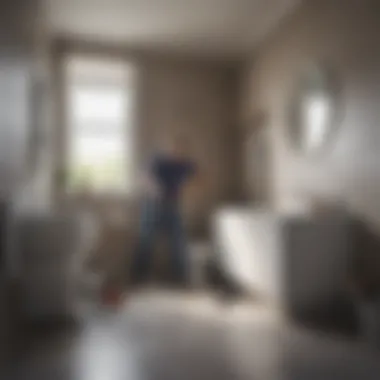Effective Solutions for a Clogged Toilet


Intro
Clogged toilets are a frustrating and common household issue. They can disrupt daily routines and create unnecessary stress. Understanding the effective solutions available is essential, helping homeowners and renters alike navigate this challenge. In this article, we will explore various methods to address a clogged toilet, examining both traditional tools and modern alternatives. Additionally, we will discuss preventive measures and when to seek professional assistance.
Clogged toilets can arise for several reasons, including excessive toilet paper use, foreign objects, or buildup in the plumbing system. Each cause may necessitate a different approach. This article will break down these methods into practical segments, making it easier for readers to identify the most suitable solution for their circumstances. With a clear focus on clarity and practicality, this guide seeks to equip you with the knowledge needed to tackle toilet clogs efficiently, ensuring a smoother home management experience.
"Understanding the root cause of a clogged toilet is key to resolving it effectively."
Each method we cover will not only detail implementation steps but will also evaluate the effectiveness and practicality of each approach. From simple budget-friendly tactics to more advanced solutions, our aim is to provide comprehensive insights into the art of unclogging your toilet with confidence.
Understanding Toilet Clogs
Toilet clogs represent a significant nuisance in everyday life, affecting both residential and commercial environments. Addressing potential clogs before they escalate can save time, money, and inconvenience. Understanding the nature of toilet clogs is crucial for effective management. This section aims to elucidate the underlying causes and recognizable signs of clogs. Knowledge can empower the user to respond swiftly and efficiently, minimizing disruptions.
Causes of Toilet Clogs
Various factors contribute to toilet clogs, each necessitating distinct approaches for resolution. One primary cause is the improper disposal of materials. Toilets are designed to handle human waste and toilet paper only. Items such as baby wipes, feminine hygiene products, or even excess toilet paper can easily create blockages.
Another common cause is mineral buildup. Over time, minerals from hard water can accumulate within the pipes, narrowing the passage and leading to clogs.
Also, foreign objects dropped into the toilet can cause immediate blockage. An inquisitive child, for instance, may inadvertently drop a toy, which can obstruct the flow.
Lastly, plumbing issues, such as tree roots infiltrating sewer lines or a damaged pipe, can lead to recurrent clogs. Immediate identification of these causes is essential for effective prevention and remediation.
Signs of a Clogged Toilet
Detecting a toilet clog in its early stages can prevent further complications. Common signs include:
- Slow drainage: Water does not retreat quickly after a flush.
- Gurgling noises: Unusual sounds from the toilet can indicate air trapped in the pipes due to blockage.
- Overflows: Water spilling over the rim indicates a severe clog that requires immediate attention.
- Pooling water: Standing water around the base of the toilet can signify leaks or clogs in the drainage system.
A keen awareness of these signs allows homeowners and users to react promptly, limiting the potential damage and ensuring a more efficient resolution.
Initial Assessment of the Clog
Evaluating the initial condition of a clogged toilet is essential before taking any action. This step ensures that you understand the situation fully, which can save time and resources. Conducting an assessment involves determining the severity of the clog and identifying its possible causes. Addressing these points early can help avoid more severe complications down the line.
Determining the Severity of the Clog
The severity of the clog can greatly influence your chosen method of resolution. A minor obstruction, such as a small build-up of toilet paper, can often be resolved quickly with a simple plunger. However, a more severe blockage may require specialized tools or techniques. To assess the severity:


- Observe the Water Level: If the water level in the toilet bowl is rising significantly after flushing, this indicates a major clog.
- Check for Slow Draining: If water drains slowly, it might suggest a partial blockage. Pay attention to how it behaves after multiple flushes.
- Inspect for Overflow: If water overflows from the bowl even before flushing, this could indicate a larger issue embedded within the pipes.
Understanding these signs allows you to choose the right tools or methods for resolution.
Identifying Possible Causes
Several factors may be contributing to the clog, and identifying them is crucial. Common causes include:
- Excessive Waste: Flushing too much waste at once can lead to quick accumulation.
- Non-Biodegradable Items: Items such as wipes, sanitary products, or toys can cause significant clogs.
- Low-Flow Toilets: These can struggle with clearing waste effectively, especially if the pipes are also partially obstructed.
- Pipe issues: Corrosion or tree root invasion can cause slower drainage and eventual blockages.
Recognizing potential causes equips you with knowledge, which can prevent similar blockages in the future. It also aids in effective communication with professionals if the problem escalates.
Tools and Equipment for Clearing a Clog
Understanding the tools and equipment available for unclogging toilets is essential for any homeowner. Different situations call for different solutions, and knowing which method to choose can save time and effort. Effective tools not only assist in resolving the clog, but also help to prevent potential damage to plumbing systems. This section will explore the different types of tools commonly used, their benefits, and how to effectively implement them.
Plungers: Types and How to Use Them
Plungers are often the first line of defense against toilet clogs. They function by using suction and pressure to dislodge the obstruction. There are two primary types of plungers: the cup plunger and the flange plunger.
- Cup Plunger: This is the basic type, with a rounded rubber suction cup. It's effective for sink clogs but can work for toilets as well, provided the cup creates a proper seal.
- Flange Plunger: Designed specifically for toilets, the flange plunger has an additional rubber flap that extends from the base. This design helps create a tighter seal, making it more effective for the unique shape of toilet drains.
To effectively use a plunger, follow these steps:
- Ensure there is enough water in the bowl to cover the plunger head.
- Position the plunger over the drain and press down to create a seal.
- Use quick, forced motions to push and pull. Repeat several times.
- If the water drains, you have successfully cleared the clog.
Augers: When and How to Utilize Them
Also known as toilet snakes, augers are a more advanced tool designed to clear stubborn clogs that plungers cannot handle. They are especially useful for deeper blockages. An auger consists of a long, flexible shaft with a corkscrew-like end that breaks up or retrieves debris causing the clog.
To use an auger:
- Insert the auger into the toilet bowl and gently push it through the drain until you feel resistance.
- Rotate the handle clockwise to extend the corkscrew tip into the clog.
- Once you feel it break through the obstruction, continue rotating to either retrieve the blockage or break it up.
- Pull the auger back out carefully.
Using an auger requires some caution as aggressive manipulation can potentially damage pipes. However, when used correctly, it is a powerful ally in managing tough clogs.
Wet/Dry Vacuums: A Practical Option
Wet/dry vacuums offer a versatile approach to dealing with toilet clogs, especially in instances of overflow or excessive blockage. These vacuums can handle both liquid and solids, making them a valuable tool for serious clogs.
Using a wet/dry vacuum involves a few steps:


- Choose the right attachment, usually a wide nozzle for efficient suction.
- Ensure the vacuum is set to handle liquids, and then place it over the toilet bowl.
- Turn on the vacuum to create suction.
- After a few moments, check the vacuum to see if the clog has cleared.
While wet/dry vacuums can be effective, they require a bit of preparation and effort, including emptying any collected waste. They are especially useful in emergencies when other methods may not be practical.
Always remember to use personal protective equipment to avoid contact with any hazardous materials during the cleaning process.
In summary, selecting the right tools for clearing clogs can significantly impact the outcome of the situation. With plungers, augers, and wet/dry vacuums at your disposal, you can tackle a variety of scenarios effectively.
Chemical Solutions for Toilet Clogs
Chemical solutions provide a potent avenue to address clogged toilets when traditional methods fail. They serve as a quick fix in many situations, allowing users to tackle the problem without the need for extensive manual intervention. However, it is essential to recognize the importance of knowing what chemicals are being applied and their potential effects. Each type of chemical solution has its own set of benefits and drawbacks, which should be considered before use.
Commercial Drain Cleaners: Efficacy and Safety
Commercial drain cleaners are widely available and are often the first go-to option for homeowners dealing with clogs. These products usually come in a ready-to-use format, containing potent chemicals designed to dissolve clogs effectively.
However, their efficacy can vary. Some drain cleaners work well on organic material like hair and soap scum, while others may struggle with more stubborn blockages caused by foreign objects. Safety is another critical aspect. Many commercial cleaners contain harsh chemicals that can be hazardous if mishandled. It is essential to follow the usage instructions carefully and consider wearing protective gear like gloves and goggles to prevent skin and eye irritation. Furthermore, be mindful of the potential for chemical reactions if combined with other substances.
Homemade Remedies: Vinegar and Baking Soda
For those seeking a more natural approach, vinegar and baking soda can be an effective solution for minor clogs. These household staples react with each other to generate carbon dioxide gas, which can help to dislodge debris in the pipes.
To use this method, pour about one cup of baking soda followed by one cup of vinegar into the toilet bowl. Allow the mixture to sit for at least 30 minutes. Then, flush the toilet. This method is relatively safe and eco-friendly, making it an appealing choice. It is worth noting, however, that this solution may not be effective against larger or more stubborn clogs.
Biological Drain Cleaners: An Eco-Friendly Approach
Biological drain cleaners represent an innovative and eco-friendly option for tackling toilet clogs. These products typically contain enzymes and bacteria that break down organic matter over time, offering a sustainable method for keeping drains clear.
The effectiveness of biological cleaners is usually slower compared to chemical solutions, as they work gradually. Nevertheless, their advantage lies in their safety for both users and the environment. Many biological cleaners are non-toxic, making them suitable for homes with pets and children. Furthermore, they help to maintain healthy plumbing systems by promoting the natural breakdown of waste without relying on harsh chemicals.
Preventive Measures to Avoid Future Clogs
Preventive measures play a crucial role in maintaining the functionality of your toilet and minimizing the risk of clogs. Taking a proactive approach can save you time, money, and stress in addressing plumbing issues. In this section, we explore specific strategies that help avoid future clogs, focusing on proper waste disposal practices and regular maintenance recommendations.
Proper Waste Disposal Practices
One of the most effective ways to prevent toilet clogs is to be mindful of what goes down the toilet. Toilets are designed to handle human waste and toilet paper only. Other items can cause significant blockage. Here are important disposal practices:
- Dispose of non-flushable items appropriately. Items such as paper towels, feminine hygiene products, and wipes, even those labeled as flushable, should never be flushed. Instead, use a trash can for proper disposal.
- Be cautious with food waste. If you are cleaning out dishes and rinsing food scraps down the sink, be aware that some of these particles can make their way to the toilet and lead to clogs.
- Educate all household members. Ensure that everyone in your home understands what can and cannot be flushed. This is particularly important for children as they may not be aware of proper disposal guidelines.
Implementing these practices can significantly reduce the likelihood of future toilet clogs, contributing to a smoother plumbing experience.


Regular Maintenance Recommendations
Regular maintenance is key to ensuring your toilet remains free from clogs and operates efficiently. Investing time in basic upkeep pays off in the long run. Here are some recommendations:
- Inspect for leaks. Periodically check for leaks around the toilet’s base, which can lead to larger plumbing issues over time. If you spot any leaks, address them immediately to avoid more serious problems.
- Clean the toilet bowl regularly. Use a toilet brush and cleaner to maintain cleanliness. This will also help remove buildup from hard water or mineral deposits that can lead to clogs.
- Use enzymatic cleaners occasionally. These eco-friendly cleaners can help break down waste buildup and keep your pipes clear without harsh chemicals.
- Test flushing efficiency. Ensure your toilet flushes effectively. A weak flush may indicate a clog in the making. If you notice any signs, it may be time to investigate further.
By adopting these preventive measures, you can effectively reduce the occurrence of clogs and enhance the longevity of your toilet. The sooner you implement these practices, the less likely you are to face the frustration of a blocked toilet in the future.
Regular maintenance and proper waste disposal are simple yet effective ways to ensure a hassle-free toilet experience.
When to Call a Professional
Assessing when to call a professional can be pivotal in maintaining proper toilet function. While many toilet clogs can be resolved with do-it-yourself methods, there are instances where professional intervention is essential. Ignoring persistent issues can lead to greater problems, including extensive damage or costly repairs.
Identifying Persistent Issues
Recognizing signs that a clog is beyond your capabilities is critical. Persistent toilet clogs often indicate deeper plumbing issues that cannot be addressed with a simple plunger or auger. Some indicators include:
- Frequent backups: If clogs are occurring regularly, it could signify underlying problems in your plumbing system rather than just a single, isolated issue.
- Multiple fixtures affected: When other plumbing fixtures in the home are experiencing slow drains or backups, the problem may lie in the main sewer line.
- Unpleasant odors: Foul smells that persist after attempting to clear a clog can indicate waste buildup in your pipes, suggesting a need for professional cleaning.
If you notice any of these issues, it is advisable to consult a plumber rather than wasting time on ineffective solutions.
Selecting a Qualified Plumber
Choosing the right plumber is an important step when professional help is necessary. A skilled plumber can accurately diagnose the issue and provide effective solutions. Here are some tips on selecting a qualified professional:
- Research credentials: Verify the plumber's licenses and insurance. This ensures they meet local regulations and standards.
- Seek recommendations: Asking friends, family, or colleagues for recommendations can lead to trustworthy professionals who have a good track record.
- Read reviews: Online platforms, such as Reddit or specialized plumbing forums, can provide insights from previous clients about their experiences.
- Obtain estimates: It’s prudent to get estimates from multiple plumbers to compare pricing and the scope of services offered.
- Evaluate customer service: A reliable plumber should provide clear communication, explaining both the problem and the proposed solutions clearly.
By following these guidelines, you can ensure that you select a plumber who will effectively address your plumbing issues and restore functionality.
Calling a professional is not a sign of failure; it reflects a wise decision to protect your home and investment.
Culmination
In summation, understanding how to effectively manage a clogged toilet is essential for any homeowner. This article highlights various methods to address this common issue, ranging from simple tools to chemical solutions. A thorough grasp of these options empowers individuals to choose the most suitable approach based on the specific circumstances of their clog.
Summary of Key Points
To ensure clarity and comprehension, the main takeaways from the article include:
- Understanding the causes of clogs: Identifying factors like excessive waste or foreign objects can prevent future problems.
- Initial assessment: Knowing the severity of a clog aids in selecting appropriate tools or methods.
- Essential tools: Using plungers, augers, and wet/dry vacuums can be effective in many situations.
- Chemical solutions: Exploring commercially available drain cleaners, homemade remedies with vinegar and baking soda, or eco-friendly biological cleaners offers a range of choices.
- Preventive practices: Proper disposal methods and regular maintenance can significantly reduce the likelihood of future clogs.
- Professional assistance: Recognizing when to seek professional help can save time and prevent further damage.
Final Thoughts on Clog Management
Effective toilet clog management requires a combination of knowledge and practical skills. The insights offered throughout this article provide a foundation for tackling clogs efficiently. Balancing immediate actions with preventive considerations can lead to sustained results. It is advantageous to keep essential tools on hand and be familiar with different solutions.
For those looking to maintain their plumbing systems, understanding the nuances of clog management not only adds peace of mind but also enhances the overall functionality of the home. Homeowners who actively engage in best practices will find that unclogging toilets can be a manageable task rather than a source of stress.







